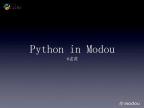加收藏
JavaScript The Good Part-JS的优缺点[Douglas Crockford, 2009]
2009年的演讲,当时的JavaScript远没有现在流行,Node.js/AngularJS刚刚发布,人们对JS还有很多质疑和误解
From computer scientists to cut-n-pasters and everyone in between.
JavaScript has good parts.
var names = ['zero', 'one', 'two',
'three', 'four', 'five', 'six',
'seven', 'eight', 'nine'];
var digit_name = function (n) {
return names[n];
};
alert(digit_name(3)); // 'three'
Perfectly Fine == Faulty
Josh Billings
No new design errors
since 1999!
第1页
JavaScript: The Good Parts
Douglas Crockford
Yahoo! Inc.
http://www.crockford.com/codecamp/
Yahoo! Inc.
http://www.crockford.com/codecamp/
第2页
The World's Most Misunderstood Programming Language
第3页
A language of many contrasts.
第4页
The broadest range of programmer skills of any programming language.
From computer scientists to cut-n-pasters and everyone in between.
第5页
Complaints
"JavaScript is not a language I know."
"The browser programming experience is awful."
"It's not fast enough."
"The language is just a pile of mistakes."
"The browser programming experience is awful."
"It's not fast enough."
"The language is just a pile of mistakes."
第6页
Hidden under a huge steaming pile of good intentions and blunders is an elegant, expressive programming language.
JavaScript has good parts.
第7页
JavaScript is succeeding very well in an environment where Java was a total failure.
第8页
Influences
Self
prototypal inheritance
dynamic objects
Scheme
lambda
loose typing
prototypal inheritance
dynamic objects
Scheme
lambda
loose typing
Java
syntax
conventions
Perl
regular expressions
syntax
conventions
Perl
regular expressions
第9页
Bad Parts
Global Variables
+ adds and concatenates
Semicolon insertion
typeof
with and eval
phony arrays
== and !=
false, null, undefined, NaN
+ adds and concatenates
Semicolon insertion
typeof
with and eval
phony arrays
== and !=
false, null, undefined, NaN
第10页
Transitivity? What's That?
'' == '0' // false
0 == '' // true
0 == '0' // true
false == 'false' // false
false == '0' // true
false == undefined // false
false == null // false
null == undefined // true
" \t\r\n " == 0 // true
0 == '' // true
0 == '0' // true
false == 'false' // false
false == '0' // true
false == undefined // false
false == null // false
null == undefined // true
" \t\r\n " == 0 // true
第11页
value = myObject[name];
if (value == null) {
alert(name + ' not found.');
}
Two errors that cancel each other out.
if (value == null) {
alert(name + ' not found.');
}
Two errors that cancel each other out.
第12页
value = myObject[name];
if (value === undefined) {
alert(name + ' not found.');
}
if (value === undefined) {
alert(name + ' not found.');
}
第13页
Good features that interact badly
Objects can inherit from other objects.
Functions can be members of objects.
for..in statement mixes inherited functions with the desired data members.
Functions can be members of objects.
for..in statement mixes inherited functions with the desired data members.
第14页
for in is troublesome
Design question: Should for..in do a shallow skim or a deep dredge?
Decision: Deep dredge. The programmer must explicitly filter out the deep members.
Except: They didn't tell anybody!
Consequence: Lots of confusion about how to use for..in.
Decision: Deep dredge. The programmer must explicitly filter out the deep members.
Except: They didn't tell anybody!
Consequence: Lots of confusion about how to use for..in.
第15页
for in is troublesome
Better Decision: Don't release the language broadly until we have enough experience to have confidence that we made the right choice.
Historical Context: Getting it right at Netscape wasn't an option.
Historical Context: Getting it right at Netscape wasn't an option.
第16页
Bad Heritage
Blockless statements
if (foo)
bar();
Expression statements
foo;
Floating point arithmetic
0.1 + 0.2 !== 0.3
++ and --
switch
if (foo)
bar();
Expression statements
foo;
Floating point arithmetic
0.1 + 0.2 !== 0.3
++ and --
switch
第17页
Good Parts
Lambda
Dynamic Objects
Loose Typing
Object Literals
Dynamic Objects
Loose Typing
Object Literals
第18页
Inheritance
Inheritance is object-oriented code reuse.
Two Schools:
Classical
Prototypal
Two Schools:
Classical
Prototypal
第19页
Prototypal Inheritance
Class-free.
Objects inherit from objects.
An object contains a link to another object: Delegation. Differential Inheritance.
var newObject =
Object.create(oldObject);
Objects inherit from objects.
An object contains a link to another object: Delegation. Differential Inheritance.
var newObject =
Object.create(oldObject);
newObject
oldObject
第20页
Prototypal Inheritance
if (typeof Object.create !== 'function') {
Object.create = function (o) {
function F() {}
F.prototype = o;
return new F();
};
}
Object.create = function (o) {
function F() {}
F.prototype = o;
return new F();
};
}
第21页
new
The new operator is required when calling a Constructor function.
If new is omitted, the global object is clobbered by the constructor.
There is no compile-time or run-time warning.
If new is omitted, the global object is clobbered by the constructor.
There is no compile-time or run-time warning.
第22页
Global
var names = ['zero', 'one', 'two',
'three', 'four', 'five', 'six',
'seven', 'eight', 'nine'];
var digit_name = function (n) {
return names[n];
};
alert(digit_name(3)); // 'three'
第23页
Slow
var digit_name = function (n) {
var names = ['zero', 'one', 'two',
'three', 'four', 'five', 'six',
'seven', 'eight', 'nine'];
return names[n];
};
alert(digit_name(3)); // 'three'
var names = ['zero', 'one', 'two',
'three', 'four', 'five', 'six',
'seven', 'eight', 'nine'];
return names[n];
};
alert(digit_name(3)); // 'three'
第24页
Closure
var digit_name = (function () {
var names = ['zero', 'one', 'two',
'three', 'four', 'five', 'six',
'seven', 'eight', 'nine'];
return function (n) {
return names[n];
};
}());
alert(digit_name(3)); // 'three'
var names = ['zero', 'one', 'two',
'three', 'four', 'five', 'six',
'seven', 'eight', 'nine'];
return function (n) {
return names[n];
};
}());
alert(digit_name(3)); // 'three'
第25页
A Module Pattern
var singleton = (function () {
var privateVariable;
function privateFunction(x) {
...privateVariable...
}
return {
firstMethod: function (a, b) {
...privateVariable...
},
secondMethod: function (c) {
...privateFunction()...
}
};
}());
var privateVariable;
function privateFunction(x) {
...privateVariable...
}
return {
firstMethod: function (a, b) {
...privateVariable...
},
secondMethod: function (c) {
...privateFunction()...
}
};
}());
第26页
Module pattern is easily transformed into a powerful constructor pattern.
第27页
Power Constructors
Make an object.
Object literal
new
Object.create
call another power constructor
Object literal
new
Object.create
call another power constructor
第28页
Power Constructors
Make an object.
Object literal, new, Object.create, call another power constructor
Define some variables and functions.
These become private members.
Object literal, new, Object.create, call another power constructor
Define some variables and functions.
These become private members.
第29页
Power Constructors
Make an object.
Object literal, new, Object.create, call another power constructor
Define some variables and functions.
These become private members.
Augment the object with privileged methods.
Object literal, new, Object.create, call another power constructor
Define some variables and functions.
These become private members.
Augment the object with privileged methods.
第30页
Power Constructors
Make an object.
Object literal, new, Object.create, call another power constructor
Define some variables and functions.
These become private members.
Augment the object with privileged methods.
Return the object.
Object literal, new, Object.create, call another power constructor
Define some variables and functions.
These become private members.
Augment the object with privileged methods.
Return the object.
第31页
Step One
function myPowerConstructor(x) {
var that = otherMaker(x);
}
var that = otherMaker(x);
}
第32页
Step Two
function myPowerConstructor(x) {
var that = otherMaker(x);
var secret = f(x);
}
var that = otherMaker(x);
var secret = f(x);
}
第33页
Step Three
function myPowerConstructor(x) {
var that = otherMaker(x);
var secret = f(x);
that.priv = function () {
... secret x that ...
};
}
var that = otherMaker(x);
var secret = f(x);
that.priv = function () {
... secret x that ...
};
}
第34页
Step Four
function myPowerConstructor(x) {
var that = otherMaker(x);
var secret = f(x);
that.priv = function () {
... secret x that ...
};
return that;
}
var that = otherMaker(x);
var secret = f(x);
that.priv = function () {
... secret x that ...
};
return that;
}
第35页
Closure
A function object contains
A function (name, parameters, body)
A reference to the environment in which it was created (context).
This is a very good thing.
A function (name, parameters, body)
A reference to the environment in which it was created (context).
This is a very good thing.
第36页
Style Isn't Subjective
block
{
....
}
Might work well in other languages
{
....
}
Might work well in other languages
block {
....
}
Works well in JavaScript
....
}
Works well in JavaScript
第37页
Style Isn't Subjective
return
{
ok: false
};
SILENT ERROR!
{
ok: false
};
SILENT ERROR!
return {
ok: true
};
Works well in JavaScript
ok: true
};
Works well in JavaScript
第38页
Style Isn't Subjective
return
{
ok: false
};
{
ok: false
};
第39页
Style Isn't Subjective
return; // semicolon insertion
{
ok: false
};
{
ok: false
};
第40页
Style Isn't Subjective
return;
{ // block
ok: false
};
{ // block
ok: false
};
第41页
Style Isn't Subjective
return;
{
ok: false // label
};
{
ok: false // label
};
第42页
Style Isn't Subjective
return;
{ // useless
ok: false // expression
}; // statement
{ // useless
ok: false // expression
}; // statement
第43页
Style Isn't Subjective
return;
{
ok: false; // semicolon
}; // insertion
{
ok: false; // semicolon
}; // insertion
第44页
Style Isn't Subjective
return;
{
ok: false;
}; // empty statement
{
ok: false;
}; // empty statement
第45页
Style Isn't Subjective
return;
{ // unreachable statement
ok: false;
}
{ // unreachable statement
ok: false;
}
第46页
Style Isn't Subjective
return
{
ok: false
};
Bad style
{
ok: false
};
Bad style
return;
{
ok: false;
}
Bad results
{
ok: false;
}
Bad results
第47页
Working with the Grain
第48页
A Personal Journey
Beautiful Code
第49页
JSLint
JSLint defines a professional subset of JavaScript.
It imposes a programming discipline that makes me much more confident in a dynamic, loosely-typed environment.
http://www.JSLint.com/
It imposes a programming discipline that makes me much more confident in a dynamic, loosely-typed environment.
http://www.JSLint.com/
第50页
WARNING!
JSLint will hurt your feelings.
第51页
Unlearning Is Really Hard
Perfectly Fine == Faulty
第52页
It's not ignorance does so much damage; it's knowin' so derned much that ain't so.
Josh Billings
第53页
The Very Best Part:Stability
No new design errors
since 1999!
第54页
Coming Soon
[ES3.1] ECMAScript Fifth Edition
Corrections
Reality
Support for object hardening
Strict mode for reliability
"use strict";
Waiting on implementations
Corrections
Reality
Support for object hardening
Strict mode for reliability
"use strict";
Waiting on implementations
第55页
Not Coming Soon
[ES4] This project has been cancelled.
Instead, [ES-Harmony].
So far, this project has no defined goals or rules.
Instead, [ES-Harmony].
So far, this project has no defined goals or rules.
第56页
Safe Subsets
The most effective way to make this language better is to make it smaller.
FBJS
Caja & Cajita
Web Sandbox
ADsafe
The next edition of ECMAScript might include a secure formal subset.
FBJS
Caja & Cajita
Web Sandbox
ADsafe
The next edition of ECMAScript might include a secure formal subset.
第57页
The Good Parts
Your JavaScript application can reach a potential audience of billions.
If you avoid the bad parts, JavaScript works really well. There is some brilliance in it.
It is possible to write good programs with JavaScript.
If you avoid the bad parts, JavaScript works really well. There is some brilliance in it.
It is possible to write good programs with JavaScript.










